|
 The Butler Bloodline... The Butler Bloodline...
Yesterday and Today
Part 2
By Kaso Kety
Photos by Ron Graham
Editor's Note: The first installment of Kaso Kety's Butler Bloodline feature (June/July '91 TLJ) dealt with the Butler herds raised by the late Milby Butler himself, F. M. "Blackie" Graves, Sam Partlow, and Michael McLeod. In Part II, Kety focuses on other prominent Butler breeders, including the Meshell brothers, Ruel Sanders, Jean Shinn and Luman Holman. We hope you enjoy the conclusion of this exclusive TLJ feature.
The Virgil Shinn Family of Longhorns
In April of 1966, when Virgil Shinn of the Quarter Circle Ranch, Idaho Falls, Idaho bought a bull and four heifers from Milby Butler, Milby threw in a steer too. Milby and Virgil had a mutual friend, a rodeo cowboy, who arranged the deal. The bull, Elmer, was a top son of the great Thomas. Elmer was Butler branded and registered as being out of Tillie, the dam of Thomas. Jean Shinn took over her father's herd and continued to breed the cattle into the 1980s.
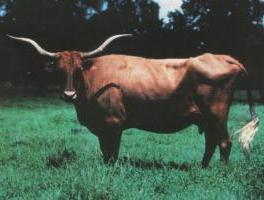 |
Above: H-R-4, a 1972 daughter of Elmer (one-half Butler breeding), bred by Holt Ranches of Montana.
Below: Holman B3, bred by Milby Butler and successfully used by Luman Holman and Ace Cattle Co of Folsom, Louisiana. |
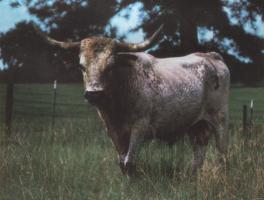 |
While the Shinn herd did not produce large numbers of cattle, they provided foundation cattle for two prominent western herds. Elmer was purchased by the Holt Ranches of Montana. While Elmer was not used on straight Butler cows, he nevertheless sired a very uniform set of offspring. He regularly produced dark colored cattle with excellent horn length and twist and, additionally, showing other characteristics typical of Butler cattle. Several of the surviving cows were sold to Tom Davis of Brigham City, Utah. Davis was heavily involved in artificial insemination and bred many of the cows to the top Butler bulls of the day.
Although only one or two of the original Circle V branded cows remain, their offsprings by Classic, Bold Ruler, Dixie Hunter and Bevo continue to pass on genetics from this small but potent pool of Butler blood.
The Holman Family of Butler Cattle
The Holman line of cattle started in 1972 at the Sealy, Texas livestock auction. Cattle buyer Richard Holman was at Sealy when he noticed a group of Butler longhorns that had been brought in for sale. Knowing of his father's keen interest in longhorns and his desire to own some, be bought the cattle and transported them back to the Holman Ranch at Jacksonville, Texas. Mr. Luman Holman couldn't have been hap pier and he has turned one lucky after noon into a 19-year love affair with the Texas Longhorn.

Country Bumpkin, a 1980 daughter of Holman B3 and a "spitting image" of Holman Cow 3. |
The group consisted of a bull dubbed Holman B1 as well as cows bred to B1, cows with calves at side, and several steers. According to the rules of the association, the herd was hardship registered as unknown Butler. Many of the cattle including the steers carried Butler's famous "OT" brand. Several of the cows sported over 50" horns in a day when a 40" horned cow would create great excitement. Two Butler branded cows that were the undisputed queens of the herd were Holman Cow 1 and Holman Cow 3. Although she produced many good calves for Mr. Holman, Cow 1 will be best remembered for her production in embryo transfer, producing two well known bulls, Don Juan of Christine by Classic and Pro by Texas Ranger JP. Many of those who saw her describe her as "a big white cow with high twisted horns of over 50 inches"...as good a cow as ever was! Cow 3 was blue and brown speckled and spotted. Her horns were flat, had a tight corkscrew twist and measured 53" tip to tip. She produced more herd sires for the Holman herd than any other cow. These included full brothers B3 and B3A, both sired by Holman B1. As Mr. Holman says, "She was that kind of cow." B1 and B3 were the most productive bulls used by the Holmans and their daughters can still be found as top producers in many different herds through out the breed. Mr. Holman states that all his herd sires have descended from this line.
Peeler and WR cows were also added to the Holman herd but many straight Butlers can still be found. Today the senior herd sire is the old B26, a son of B1 and Cow 11, with several homegrown bulls waiting in the wings.
Holman cattle are best known for their productivity and milking ability, but they probably possess as diverse a color range as is found in any family of Longhorns as well as outstanding scale and conformation. While many of the cattle have superior horns, the Holman emphasis has not been on horn, but rather on the selection of cattle that fit the Holman mold of rugged cattle that can survive whatever is thrown at them and still come up smiling. They are a cattleman's cattle and Mr. Luman Holman wouldn't have it any other way.
Ruel Sanders and the great Bevo
The Ruel Sanders herd of Butler cattle also started in the early seventies, but this time at the Hockley auction near his home of Magnolia, Texas. Mr. Sanders' friend, Pete Jones, called and told him that some Butler Longhorns were selling at Hockley. All the animals were Butler branded and numbered six cows and one bull. They had been sold by Pauline Russell shortly before at the Raywood auction and then trucked to Hockley for resale. The bull turned out to be Bevo. Longhorn enthusiasts need no introduction to the great old bull whose blood runs through as many Longhorns as any individual in the breed. Bevo was used until 1980 when he was acquired by Dewitt Meshell from the Sanders. A number of truly outstanding progeny were produced from Bevo and the six original cows. Bevo was also bred regularly to his own daughters with excellent results.

The twisty-horned Miss Magnolia (Bevo x White Lace) is the queen of Ruel Sander's herd. |
These original cows included the 54" White Lace. White Lace was a breathtakingly beautiful cow and had the production to match! Her offspring included full sisters, Miss Magnolia and Lady Magnolia. Miss Magnolia stands at the top of the herd today. She possesses one of the best sets of twist horns of any living Butler cow. This breeding also produced the very popular and massive horned Jumbo Horns bull. A number of the original set carried the unique Butler color pattern of a red or brown lineback with a "Lacy-face". These cows were christened "Lineback" with their private herd numbers.
Bevo also possessed this color pattern and the Sanders quickly found themselves with quite a number of these "Lineback" cattle In addition to females such as Lineback 11, Lineback 12, and Easter, some very good Bevo sons and grandsons were raised. Among the most notable were Bevo Jr., Bimbo, Bevo II, Bevo III and Pete. These bull were used to varying degrees after the departure of Bevo. The all-Butler Dixie Cavalier, a Blackie Graves-bred Dode's Boy son, has been used with great results.
I regret to admit I have had only one opportunity to visit the Sanders, but I remember the herd to have excellent size for East Texas cattle. The color present in the herd was very impressive with very few white cattle. The horn in the herd was excellent in both length and shape.
Most breeders have found Mr. Sanders will sell bulls much faster than he will part with females, so it has been the bulls of this herd that have had the most impact on outside herds. For Butler fans, the Sanders herd is considered a real treat as it is more representative of the Butler cattle of the fifties and sixties. Not only are the cattle exceptional, but so is the hospitality of the Sanders' family!
Dewitt and Sammy Meshell: A Love for Horns
The Meshell line of Butler cattle started in 1968 when Dewitt Meshell and his brother Sammy became partners and bought seventeen head from Milby. They purchased seven more when the Butler estate was sold after Milby's death in 1971. The Meshell herd was later split and due to health reasons, Sammy has had to drastically reduce his cattle numbers in recent years. Dewitt and his wife Evelyn, however, remain as active as ever. The Meshells had helped out on the Butler ranch during the sixties and they were able to spend many hours visiting with Milby and Henry studying their cattle. If you are looking for an education in Butler cattle, Dewitt is definitely the professor. His Butler mini-museum is always worth a visit and contains many photographs and newspaper articles on Butler cattle that can't be found anywhere else.
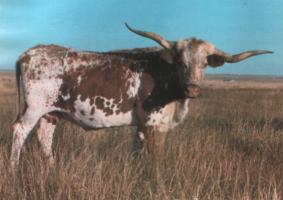
The unique Droophorns a foundation Meshell female, possessed one of the tightest sets of twist horns known to exist in the Longhorn breed. |
The Meshell herd has focused on linebreeding the genetics of the old Lone Ranger 72 bull. He was a brown bull that Milby had picked out as a yearling for the Meshells. He was by Tommie out of Sunshine, an old brown cow with double twist corkscrew horns. The original cows purchased as heifers developed into some of the finest Butler cows the breed has seen. These include Droophorns, Freckle Neck, Speedlimit, Red Neck, Frosty Face, Little Emmie, Pencil Horns, and White Horns 68. Lone Ranger produced a number of out standing progeny out of these fabulous Butler females. Bulls include Mr. Frost. Little Man, DuBose's Butler Blue, and the great Blue Horns. Blue Horns really propelled Dewitt's program into the spotlight. Blue Horns replaced the aging Lone Ranger as Dewitt's main herd sire, producing fabulous results when bred back to Lone Ranger daughters and granddaughters. In the early 1980's, Dewitt obtained a number of bulls from the herd of Ruel Sanders. The acquisition of the legendary Bevo was perhaps Dewitt's greatest joy. Bimbo and Jumbo Horns were also used quite a bit. Dewitt has replaced Blue Horns with Superior, a Blue Horns son out of the immortal Droophorns.

This excellent straight-Butler steer owned by J.W. Isaacs of Alvin, Texas shows the eye-catching qualities of the best Butler cattle. |
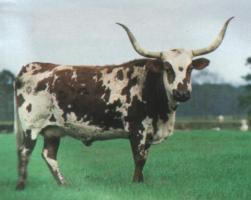
Duchess Anne, a 1976 Edward Faircloth cow and a combination of Graves and Pauline Russell breeding. |

Katz Meow (Classic x Rose Red), bred by Darol Dickinson, is a combination Graves and Partlow Breeding. |
Droophorns possessed the tightest corkscrew horns known to exist. Superior has long been considered to be the best son of Blue Horns. In recent years Dewitt has begun using Classic line bulls on his foundation genetics with great results. He is also very pleased with a He's a Ten son obtained from Michael McLeod. While nearly all the original cows have passed on, Dewitt has been able to, in most cases, retain a daughter or two out of each. While Dewitt does not breed for color, one cannot help but marvel at the wide range of colors and patterns and at the consistency with which the herd produces horns with length and shape typical of the old Butler herd. Milby Butler bred for horn base with extreme twist and this preference is alive and well in Dewitt's program. Dewitt has often said that the conformation and color will take care of themselves, but you must pay close attention to horns-breed for horns!
Dewitt has collected quite a large group of cattle representing Butler blood that had been dispersed and used in other herds. It is his attempt to preserve as much genetic diversity within the Butler bloodline as possible, as he cannot stand the thought of any of it disappearing.
There are three more breeders which I feel deserve to be mentioned in an article on Butler cattle. While they did not run straight Butler programs, they nonetheless have done as much to breed and promote this family as anyone ever has. Mr. J.W. Isaacs and Mr. Johnnie Hoffman recognized the benefits of using Butler cattle early on and continue to use them heavily today, especially Butler bred bulls. Their straight Butler and Butler bred cattle rank with many of the best ever produced.
I would also like to recognize Mr. Robert Harrell as well. No one else has ever gone to as much trouble or spent as much time and money to acquire the finest females from many of the premium Butler herds in an effort to cross them with Butler bulls of unrelated line. Many of the matings would never have occurred without Robert Harrell's efforts, yet because they did, we have a clearer understanding of how the Butler lines interact with one another, not to mention the fabulous cattle his breeding program produced.
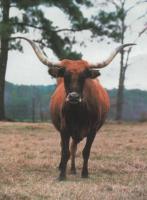
Little Brownie, a product of the Wiley Knight breeding program, combines Butler Boy with Graves and Partlow breeding. |
In addressing the issues of size and color, several points must be remembered. While white cattle are prevalent enough among Butler herds, there are at least as many solid red ones. It also happens that the most desirable bulls in terms of horn growth, have been white. In the search for increased horn growth, white bulls have been used to a larger extent than their colorful cousins and it just so happens these were some of the few Butler bulls available at the time. However, white cattle occur in every family of Longhorns. It is readily accepted that this color pattern traces to the White Parks breed. The White Parks cattle were one of the original breeds blended with other British, European, and Spanish cattle in the wild, over hundreds of years to produce the breed known as the Texas Longhorn But as to color, isn't it really more important to judge a cow on her ability to raise a calf?
Size also seems to be of major concern to today's Longhorn breeders. Hopefully, it is not selection for uncharacteristically larger animals, but rather selection away from an excessively small one. Butler cattle have traditionally shown excellent size for this geographic region and all the Butler herds have numerous examples to prove it. Obviously genetics play a major role, but do not forget nutrition is just as important. Don't forget, all areas of this country were not created equally. Because of the relatively poor nutrition of East Texas, West Louisiana, and Gulf Coast, it is known that cattle raised in these areas do not , attain the size and scale of cattle raised in northern or western geographic areas, regardless of pedigree! An excellent article dealing with this, "Size in Cattle," by the late Dr. Jan Bonsma appears in the January 1990 issue of the Texas Longhorn Journal. Isn't it curious that Butler cattle raised in Colorado and Wyoming are suppose to represent the largest lines in terms of an animal's physical size? Next time you have an opportunity, compare the size and scale of a cow to where the cow was raised. I think you'll discover some very revealing trends.
In closing, I would again like to stress that the Butler bloodline offers much diversity. This has become even more so in the last few years as the number of Butler breeders has grown. Also in recent years, more Butler cattle have become available and the established Butler breeders have exchanged bulls with one another. These factors have resulted in fabulous offspring which only serve to make the future for the Butler blood line brighter than ever. This is not to say every mating will be successful. Care must be taken when selecting matings, just as in any family or breed of cattle.
If the success or failure of established programs is documented and studied, the odds of success in your program are greatly increased. I suggest a visit to these or any of the many Butler breeders who would love the opportunity to dispel myths and propaganda by showing visitors shining examples of cattle that are a living legacy to Milby and Henry Butler's lifetime of selection and caring for a breed they both loved and respected so very much.
Material is courtesy of LonghornJournal.com |
|